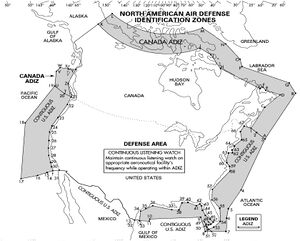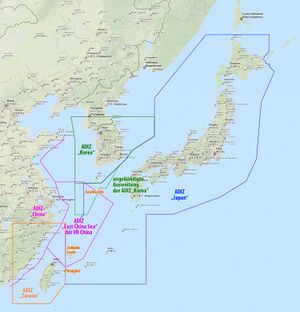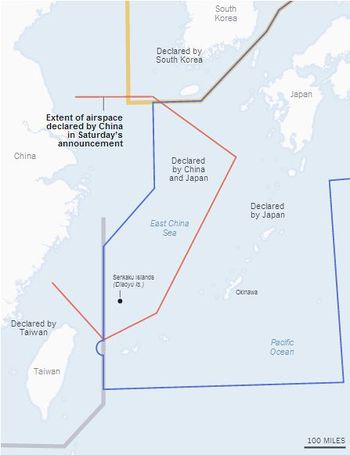منطقة تمييز للدفاع الجوي
منطقة تمييز للدفاع الجوي Air Defense Identification Zone (ADIZ)، هي مجال جوي يكون فيه التمييز المهيأ، الموقع، مراقبة الطائرات المدنية على الأرض أو المياه، مطلوب لصالح الأمن القومي.
. . . . . . . . . . . . . . . . . . . . . . . . . . . . . . . . . . . . . . . . . . . . . . . . . . . . . . . . . . . . . . . . . . . . . . . . . . . . . . . . . . . . . . . . . . . . . . . . . . . . . . . . . . . . . . . . . . . . . . . . . . . . . . . . . . . . . . . . . . . . . . . . . . . . . . . . . . . . . . . . . . . . . . . .
الولايات المتحدة وكندا
The United States and Canada jointly operate an ADIZ that encompasses their sovereign airspace in North America. The United States maintains two zones in North America — the Contiguous U.S. ADIZ and Alaska ADIZ — and two more overseas — Hawaii ADIZ and Guam ADIZ.[1] Canada operates two other sections of the North American ADIZ, one off the Pacific coast of British Columbia and another that encompasses the Canadian Arctic Archipelago and its Atlantic provinces.[2]
Under US law and policy, the zone applies only to commercial aircraft intending to enter US airspace.[1] An air defense command and control structure was developed in 1950, creating five air defense identification zones around North America. If radio interrogation failed to identify an aircraft in the ADIZ, the Air Force launched interceptor aircraft to identify the intruder visually. The air defense system reached its peak in 1962. With the deployment of the SS-6 ICBM in the USSR, strategic threats shifted overwhelmingly to ICBM attacks, and bomber intrusions were considered to be less of a threat. It does apply to aircraft passing through the zone to other countries.
اليابان
لليابان منطقة تمييز دفاع جوي تتداخل مع معظم مناطقها الاقتصادية الخالصة. رسمت حدودها الشرقية بعد الحرب العالمية الثانية من قبل الجيش الأمريكي عند 124° شرق. أدى هذا إلى النصف الشرقي فقد من جزيرة يوناگوني أصبح جزءاً من منطقة تمييز الدفاع الجوي اليابانية وأصبح النصف الشرقي جزءاً من منطقة تمييز الدفاع الجوي التايوانية. هكذا، وفي 25 يونيو 2010، وسعت اليابان منطقة تمييز دفاعها الجوي حول هذه الجزيرة لمسافة 22 كم غرباً.
أدى هذا إلى التداخل مع منطقة تمييز الدفاع الجوي التايوانية وعبرت حكومة تايوان عن "أسفها" على التحرك الياباني.[3] فيما يخص ساحل البر الرئيسي الصيني، تبعد منطقة تمييز الدفاع الجوي اليابانية 130 كم عن أقرب نقطة على الساحل الصيني.[4]
According to China Network Television on 24 November 2013, China and Russia do not recognize Japan's ADIZ.
تايوان
Taiwan has an ADIZ that covers most of Taiwan Strait, part of the Chinese province of Fujian, Zhejiang, and Jiangxi, part of East China Sea and adjacent airspace, most ADIZ of Taiwan is built on its exclusive economic zone. Taiwan's ADIZ was designed and created by the United States Armed Forces (USAF) after World War II. [5]
كوريا الجنوبية
South Korea operates a zone that covers most but not all of its claimed airspace.[6] It does not cover some remote spots.[6] The zone was established in 1951, during the Korean War, by the United States Air Force to block communist forces.[6] In 2013, in response to the establishment of a Chinese zone that covers disputed territory, the South Korean government considered expanding their zone to include islands of Marado and Hongdo, and Ieodo, a submerged rock within the overlapping exclusive economic zones of South Korea and China.[6]
When part of or the whole flight route of an aircraft enter the KADIZ area, it is required to send a specific flight plan one hour prior to departure. Civilian aircraft with regular routes should submit a repetitive flight plan to the air traffic control. There is no need for legal action when an aircraft enters KADIZ as long as the aircraft follows its flight plan reported to the South Korean government. If there is a change in the flight passage or an approach without prior notification, the South Korean air force has the right to immediately identify or track down the aircraft and be prepared for interception. However, military force such as shooting down the plane cannot be exercised.
On December 8, 2013, the Defense Ministry of Republic of Korea announced the expansion of the Korea Air Defense Identification Zone (KADIZ). After South Korea expanded KADIZ and China established their ADIZ in 2013, certain areas overlap with each other. The KADIZ boundary area at northwest Jeju Island (about 2,300 km2) overlaps with the East Chinese Sea. Also, South Korea's domestic aircraft cannot avoid entering China's ADIZ near Ieodo even if the flight's purpose is for rescue or searching distressed/missing aircraft. More tension is increasing as the area of South Korea, China and Japan's FIR reiterate with each other.[7] These sensitive issues are expected to bring military or diplomatic conflict between the three countries. By 29 August, Chinese military jets had entered the KADIZ area without notice five times in 2018.[8]
الصين
أنشأ البر الرئيسي للصين نسخته الخاصة من منطقة تمييز الدفاع الجوي في 23 نوفمبر 2013، والتي تغطي جزر دياويو/سنكاكو المتنازع عليها.[9][10][11][12] تضمن الجدل حول هذه الخطوة: تعليقات من وزير الدفاع الأمريكي تشك هيگل والذي وصف الخطوة الصينية على أنها "محاولة زعزعة استقرار لتغيير الوضع الراهن في المنطقة".[13]؛ استدعاء كوريا الجنوبية لدبلوماسي صيني في 25 نوفمبر للاحتجاج على إنشاء المنطقة، والذي تضمن صخرة سوكوترا التي تطالب بها كوريا حيث أقامت كوريا منشآت هناك.[14] ووزارة النقل الكورية الجنوبية التي قالت أنه خطوط طيرانها لن تعترف بمنطقة تمييز الدفاع الجوي الصينية، والتي حسب الوزارة، لا تمتثل للوائح الدولية؛[15] احتجاجات من الحزب التقدمي الديمقراطي التايواني المعارض وبعض الأكاديميين الذين أكدوا أن حكومة ما ينگ-جويو فشلت في فرض السيادة التايوانية؛[16][17] واستدعت أستراليا السفير الصيني للاحتجاج على الحادث.[18]
أرسلت الولايات المحدة قاذفتي قنابل طراز ب-52 من گوام للتحليق داخل المنطقة في 26 نوفمبر، وزعمت أن هذا تم "بدون أن يبدي الصينيون رد فعل".[19] صرحت الحكومة الصينية أنها رصدت الطائرات الأمريكية وأنها في الوقت الذي لم تقوم فيه أي تحرك،[20] فإن لديها القدرة على "السيطرة على نحو فعال على المجال الجوي ذو الصلة".[بحاجة لمصدر] إلا أن المتحدث الرسمي باسم الپنتاگون صرح أن الطائرات لم يتم رصدها أو الاتصال بها من قبل الطائرة الصينية.[21] كذلك صرحت وزارة الدفاع الصينية أنه فيما يتعرض بفرض السيطرة على المنطقة، فسوف يتخذ الجيش "رداً يتفق مع الوضع ومستوى التهديد".[22]
مساعد وزير الخارجية الصيني ژنگ زگوانگ صرح بأن منطقة تمييز الدفاع الجوي الصينية تهدف إلى الدفاع عن السيادة القومية الصينية وتأمين أراضيها ومجالها الجوي، وأكد أن هذا يتفق مع ميثاق الأمم المتحدة.[23]
خطوط الطيران والسلطات الآسيوية صرحت بأنها ستعلم الصين قبل أن تدخل خطوط طيرانها منطقة التمييز، لكنها لن تغير مسارها أو جداولها.[24]
الولايات المتحدة واليابان صرحتا بأنهما سيتجاهلان منطقة تمييز الدفاع الجوي الصينية ولن يتمثلان للأوامر الصينية. أعلن هيگل أن البيان الصيني "لن يغير بأي حال من الأحوال العمليات العسكرية التي تقوم بها الولايات المتحدة في المنطقة". كذلك كرر الموقف الرسمي لادارة اوباما والذي يعلن أن الولايات المتحدة ستدعم تلقائياً اليابان في حالة الحرب مع الصين على جزر دياويو/سنكاكو. [25]
صرحت الصين أن الولايات المتحدة يجب أن "تعتبرها أمراً مسلم به" حقيقة أن أكثر من 20 بلد، وتشمل الولايات المتحدة واليابان، تقوم بإنشاء مناطق تمييز الدفاع الجوي الخاصة بها وأن "بمجرد ما بدأت الصين في ذلك، عبرت واشنطن عن مخاوفها على الفور"، وأضافت "أنهم يمكنهم فعل ذلك بينما الصين لا يمكنها".[26] في 27 نوفمبر، صرحت وزارة الدفاع الصينية أن العسكرية الصينية "رصدت المسار الكامل لطائرات أمريكية غير مسلحة طراز ب-52، كانت تحلق على امتداد الحدود الشرقية لمنطقة الطيران، على بعد 200 كم شرق جزر دياويو" وأن الصين ستقوم بالرد ما يتوافق مع الوضع ومستوى التهديد".[22]
في افتتاحية لصحيفة واشنطن پوست جاء أن الصين يجب أن تلغي منطقتها الجوية الممتدة على الجزر محل النزاع، "منذ سنوات، أكد قادتها للعالم أن القوى الاقتصادية العظمى المتصاعدة لا تعني أكثر من مجرد صين قوية، في المنطقة أو ما خلفها. وأطلقوا عليها "الصعود السلمي للصين". البيان الذي صدر في نهاية الأسبوع يبدو أنه لا يعني شيئاً. بالفعل مطالب الصين على الجزر طويلة الأمد. لكن وضع القيود المفاجأة على الحركة الجوية على مثل هذه المساحة الواسعة من الأرض ليس "صعود سلمي" ولا دلالة على وجود إستعداد للتفاوض."[27]
في 28 نوفمبر 2013 حقت طائرة عسكرية يابانية داخل منطقة تمييز الدفاع الجوي الصينية، وصرح متحدث باسم الحكومة اليابانية أنه لم يصدر أي استجابة من الجانب الصيني على هذا التحليق. قام عدد غير محدد من طائرات الدورية اليابانية بالتحليق في رحلات استطلاع روتينية، ولم تهرع المقاتلات الصينية لاعتراضها.[28]
المصادر
- ^ أ ب خطأ استشهاد: وسم
<ref>غير صحيح؛ لا نص تم توفيره للمراجع المسماةAbeyratne - ^ "Designated Airspace Handbook" (PDF). Nav Canada. 25 أبريل 2019. Archived from the original (PDF) on 16 يونيو 2019. Retrieved 23 يوليو 2019.
- ^ "Japan extends ADIZ into Taiwan space". taipeitimes.com. Taipei Times. 26 June 2013. Retrieved 24 November 2013.
- ^ "Japan scrambles fighters over Diaoyu". Globaltimes. Retrieved 24 November 2013.
- ^ "Chinese aircraft enters Taiwan's ADIZ for 7th time in 8 days | Taiwan News | 2020-09-25 10:59:00".
- ^ أ ب ت ث "Seoul considers southward expansion of air defense zone". The Korea Herald. December 2013. Retrieved 1 December 2013.
- ^ "Air defense zones of China, S. Korea overlap", Yonhap news, November 24, 2013
- ^ "Chinese military jet enters S. Korean air defense zone". Yonhap News. 29 August 2018.
- ^ BUCKLEY, CHRIS (23 November 2013). "China Warns of Action Against Aircraft Over Disputed Sea". nytimes.com. The New York Times Company. Retrieved 23 November 2013.
- ^ "Japanese air defense zone includes Chinese EEZ: report". wantchinatimes.com. 5 November 2013. Retrieved 24 November 2013.
- ^ "Japanese Air-Defence Identification Zone". Sun Bin. Retrieved 24 November 2013.
- ^ "China maps out its first air defense ID zone". China Central Television. Retrieved 24 November 2013.
- ^ Fabey, Michael (24 November 2013). "Chinese Move Prompts Pentagon Response". aviationweek.com. Penton. Retrieved 25 November 2013.
- ^ China Hit with Complaints Over Maritime Air Defense Zone Voice of America 25 November 2013
- ^ Alastair Gale (27 November 2013), South Korea Familiar With B-52 Show of Force The Wall Street Journal
- ^ Shih Hsiu-chuan (28 November 2013), ADIZ response a sign of surrender: academic Taipei Times
- ^ Air defense zone in line with cross-Strait interests: Spokeswoman Xinhua 27 November 2013
- ^ "US defies China's fly zone with B-52 flight". Agence France-Presse. 27 November 2013.
{{cite web}}: Italic or bold markup not allowed in:|publisher=(help) - ^ Freedberg Jr., Sydney J. (26 November 2013). "US Tests New China Air Defense Zone With B-52s; PRC Move Drives Korea, Japan Together". breakingdefense.com. Breaking Media, Inc. Retrieved 26 November 2013.
- ^ Jane Perlez (27 November 2013), China Explains Handling of B-52 Flight as Tensions Escalate The New York Times
- ^ Felsenthal, Mark (Nov 27, 2013). "U.S. affirms support for Japan in islands dispute with China". Reuters.
- ^ أ ب "Air zone said not to affect routine flights date=27 November 2013". chinadaily.com.cn. China Daily. Retrieved 27 November 2013.
{{cite web}}: Missing pipe in:|title=(help) - ^ "China refutes Japan's protest at ADIZ over East China Sea".
- ^ Blanchard, Ben; Kelly, Tim (25 November 2013). "Asian airlines to give flight plans to China after airspace zone created". reuters.com. Thomson Reuters. Retrieved 25 November 2013.
- ^ Chan, John (26 November 2013). "Heightened tensions over China's air defence zone". www.wsws.org. ICFI. Retrieved 26 November 2013.
- ^ "Commentary: U.S, Japan wrong to blame China for air zone date=26 November 2013". http://news.xinhuanet.com. Xinhua. Retrieved 26 November 2013.
{{cite web}}: External link in|website=|title=(help) - ^ "China must rescind its air zone over disputed islands". Washington Post.
- ^ "Japan and South Korea Fly Military Planes in Zone Set by China". نيويورك تايمز. 2013-11-28. Retrieved 2013-11-28.


